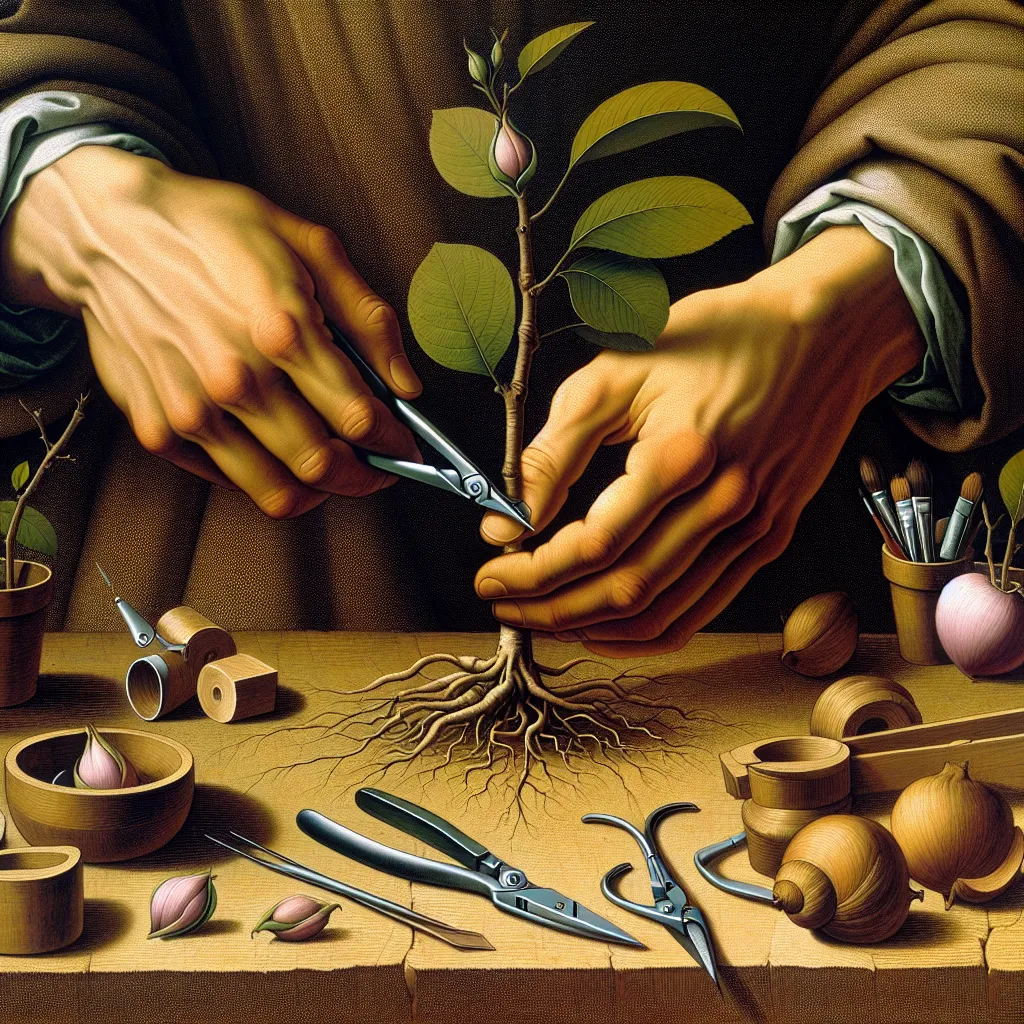
- Published on
- Authors

- Name
- ric de yuga 😄
🌱 The Science and Art of Grafting Plants
Grafting is a horticultural technique that involves joining two plants together so that they grow as one. This method is widely used in agriculture and gardening to propagate desirable plant varieties, improve disease resistance, and enhance growth characteristics. This blog post delves into the technical science behind grafting and provides a detailed step-by-step guide to grafting plants successfully.
🔬 The Science Behind Grafting
Grafting is based on the principle of tissue fusion. When two plant tissues are brought into close contact, they can grow together and form a single plant. This process involves several biological mechanisms:
Cambium Layer:
The cambium is a layer of actively dividing cells located between the xylem (wood) and phloem (bark) of a plant. Successful grafting relies on aligning the cambium layers of the scion (the upper part of the graft) and the rootstock (the lower part of the graft). The cambium cells from both parts must touch and grow together to form a continuous vascular system.
Callus Formation:
After the cambium layers are aligned, a callus forms at the graft junction. This callus is a mass of undifferentiated cells that helps heal the wound and initiates the fusion of the grafted parts.
Vascular Connection:
Over time, the callus cells differentiate into vascular tissues (xylem and phloem), creating a functional vascular connection between the scion and rootstock. This connection allows the transport of water, nutrients, and hormones between the two parts, enabling them to grow as a single plant.
🌟 Benefits of Grafting
- Propagation of Desirable Varieties: Grafting allows the propagation of plants that do not root well from cuttings or seeds.
- Disease Resistance: Grafting onto disease-resistant rootstocks can improve the overall health and resilience of the plant.
- Enhanced Growth: Grafted plants can exhibit better growth characteristics, such as increased vigor and improved fruit quality.
- Space Efficiency: Multiple varieties can be grafted onto a single rootstock, saving space in small gardens.
✂️ Step-by-Step Guide to Grafting Plants
Materials Needed:
- Sharp grafting knife or razor blade
- Pruning shears
- Grafting tape or rubber bands
- Rootstock and scion
- Disinfectant solution (e.g., 70% isopropyl alcohol)
- Parafilm or grafting wax (optional)
Step 1: Select Compatible Rootstock and Scion
Choose a healthy rootstock and a scion from a desirable variety. Ensure that both are of similar diameter for better cambium alignment.
Step 2: Prepare the Rootstock
- Cut the Rootstock: Make a clean, straight cut across the rootstock using a sharp grafting knife or pruning shears.
- Create a Slit: Make a vertical slit (about 1-2 inches long) in the center of the cut surface to create a “T” or “V” shape.
Step 3: Prepare the Scion
- Cut the Scion: Cut the bottom end of the scion into a wedge shape, ensuring that the cambium layer is exposed.
- Disinfect the Scion: Dip the scion in a disinfectant solution to prevent infection.
Step 4: Graft the Scion to the Rootstock
- Insert the Scion: Carefully insert the wedge-shaped end of the scion into the slit of the rootstock, ensuring that the cambium layers of both parts are in contact.
- Secure the Graft: Wrap the graft junction tightly with grafting tape or a rubber band to hold the scion in place and protect the graft site.
Step 5: Protect the Graft
- Seal the Graft: Cover the graft junction with parafilm or grafting wax to prevent desiccation and protect against pathogens.
- Support the Plant: Stake the grafted plant if necessary to provide support and prevent damage from wind or handling.
Step 6: Care for the Grafted Plant
- Watering: Keep the soil moist but not waterlogged. Proper hydration is crucial for the graft to take.
- Shading: Provide partial shade to the grafted plant to reduce stress and promote healing.
- Monitoring: Regularly check the graft for signs of successful fusion, such as new growth and callus formation.
🌿 Conclusion: Mastering the Art of Grafting
Grafting is a powerful technique that combines the best characteristics of different plants, leading to healthier, more productive, and resilient plants. By understanding the science behind grafting and following a meticulous step-by-step process, gardeners and horticulturists can successfully graft plants and enjoy the numerous benefits this technique offers. Happy grafting!
